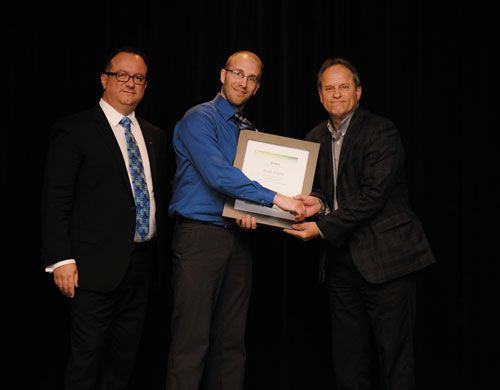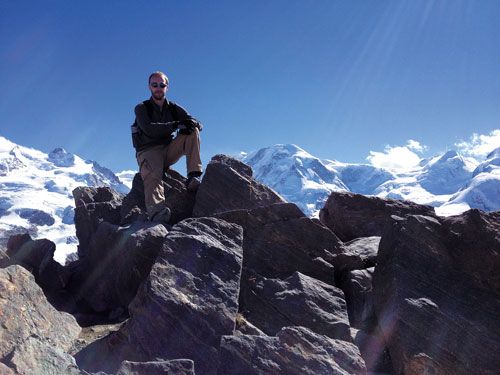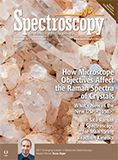The 2017 Emerging Leader in Molecular Spectroscopy Award
Spectroscopy
Russ Algar, the winner of Spectroscopy’s 2017 Emerging Leader in Molecular Spectroscopy Award, is developing fluorescence assays and measurement systems based on quantum dots. One day, these methods may enable smartphone-based medical diagnostics.
Russ Algar, an assistant professor in chemistry at the University of British Columbia (UBC), in Vancouver, Canada, has won the 2017 Emerging Leader in Molecular Spectroscopy Award, which is presented by Spectroscopy magazine. This annual award recognizes the achievements and aspirations of a talented young molecular spectroscopist, selected by an independent scientific committee. The award will be presented to Algar at the SciX 2017 conference in October, where he will give a plenary lecture and be honored in an award symposium, both on Monday, October 9.
Imagine your doctor taking out a cell phone one day and using the camera to diagnose an illness or to run a series of tests that lead to a more accurate result than current technology allows. If those dreams of “personalized medicine” become a reality one day, it will be in part, thanks to the research that Russ Algar, an assistant professor in chemistry at the University of British Columbia (UBC), in Vancouver, Canada, has been doing. In many respects, Algar is leading the charge to combine analytical chemistry and personalized medicine by developing smartphone-based point-of-care diagnostics in which photoluminescence from semiconductor quantum dot (QD) nanocrystals is measured by a smartphone camera. He is also working on fluorescence assays that target protein biomarkers and cell types, and QD-based concentric Förster resonance energy transfer (cFRET) probes with multifunctional detection capabilities.
This article highlights the work Algar has accomplished so far and his future research plans, and shares some insights into Algar and his work from friends and colleagues.
A Stellar Candidate
Russ Algar

The Emerging Leader in Molecular Spectroscopy award recognizes the achievements and aspirations of a talented young molecular spectroscopist. Algar was highly recommended for the 2017 award by Chris Orvig, a professor of chemistry and pharmaceutical sciences and director of the Medicinal Inorganic Chemistry Group at UBC. Orvig explained that Algar was hired at UBC to strengthen their analytical division with spectroscopy expertise, and he truly excelled in that endeavor. “He is a stellar candidate for this new young researcher award and I am delighted to recommend him in the strongest possible terms,” said Orvig.
Denis Boudreau, a professor at the Université Laval, calls Algar “a rising star” on the Canadian academic scene. “The development of novel spectroscopy tools and materials for chemical analysis is an important research field with potentially major impacts in the analytical chemistry and biotechnology sectors,” said Boudreau. “Professor Algar is already one of the most prominent and promising young actors in this field.”
Algar has certainly achieved a great deal in his short career. He received his PhD in 2010 (from the University of Toronto, under Ulrich J. Krull), and has been an assistant professor at the University of British Columbia since 2012. In that short time, he has published more than 75 manuscripts and several book chapters with more than 3000 citations according to the ISI Web of Science. He has also delivered more than 50 presentations at national and international conferences. In addition, Algar has been the recipient of several awards such as the Fred Beamish award (see photo on next page) and an Alfred P. Sloan Research Fellowship in 2017.
Algar is also active in the broader scientific community through his work with various conferences, editorial advisory boards, and scientific societies. For example, this year Algar was the co-organizer for two Canadian Society for Chemistry (CSC) symposia. Algar is also a member-at-large on the CSC Analytical Chemistry Division and a member on the board of directors for the Chemical Education Fund-among others.
Given his body of work, it’s easy to see why Algar was nominated for our award. But how did he first become interested in analytical chemistry and molecular spectroscopy? Algar said his broad interest in analytical chemistry evolved naturally as part of his undergraduate studies and the way his mind works. He also cited the diversity that can be found in analytical chemistry and molecular spectroscopy as something that attracted him to those fields. “Analytical chemistry and molecular spectroscopy embrace technology, enable new fundamental discoveries about how nature works, strive to create practical inventions, and easily interface with other disciplines in chemistry, biology, physics, material science, and engineering,” he said. “I really like having such a wide range of space in which to work and explore.”
Algar receiving the Fred Beamish Award (sponsored by Thermo Fisher Scientific) from Mark James of Thermo Fisher Scientific. At left: Canadian Society for Chemistry (CSC) President Rui Resendes. (Photo courtesy of CSC, specifically Gale Thirlwall.)

A Passion for Exploration
Exploration seems to be a passion for Algar, as he delves into new research areas with the excitement and thoroughness of an early adventurer. For Algar, an idea can open a whole new world of possibility. For example, his work creating fluorescence assays to target protein biomarkers and cell types was inspired by the concept of molecular medicine, which focuses on understanding and assessing pathologies at the level of molecular mechanisms and cellular processes rather than the systemic observations of classical medicine.
For example, rather than looking at blood pressure, temperature, coughing, and other symptoms of disease, Algar explained, in molecular medicine, one would look at the levels of certain proteins, genes, and cell types. “Many people believe that molecular medicine is the key to earlier diagnosis of diseases and more effective interventions, resulting in better health,” he said. “An important concept within this context is personalized medicine, where medical interventions are tailored to the specific manifestation of a disease in an individual rather than the population average, and adjusted over time while monitoring the specific response of that individual to the intervention.”
These concepts are great in theory, but there is a measurement problem in making them a viable reality: Many measurements need to be made at multiple time points. “The model of having a doctor order tests and collect a sample, or having the patient go to a specialized laboratory, is not going to be sufficient,” he said. Instead, what’s needed is a model were nurses can do some tests at the hospital bedside, doctors can do some at their private practice, and patients can do some tests at home. “Smartphone-based assays for protein and cell biomarkers can potentially enable this new model,” he said.
Smartphone-based assays also have the potential to address the discrepancy in health care provided to people in urban and rural communities. People in rural or remote communities often must travel far for medical care, and about half of the health care budget in one of Canada’s northern territories is dedicated to patient travel. “If molecular assays are available in the form of a smartphone assay, then they can be available in rural and remote communities without specialized labs,” Algar said. “This benefits both the patient and the health care budget.”
But a smartphone assay is not a magic bullet, Algar is quick to point out. “The full solutions to health care challenges will have many moving parts,” he notes. “But the concept embodied by the smartphone assay is likely to be an important component.”
How exactly will smartphone-based assays work? Algar and his group’s initial research in this area focused on finding and characterizing the best materials for fluorescence-based assays with smartphones. They began focusing on QDs, which are much brighter than conventional fluorescent dyes, making their fluorescence easier to detect and translating into a more sensitive assay. It’s even possible, Algar explained, to use blue light filtered from the camera flash to excite measurable fluorescence from a QD. And the emission of QDs can be precisely tuned to match the built-in color filters of a smartphone camera (red-green-blue or RGB), to help improve sensitivity and facilitate the use of the different RGB color channels to detect different assay targets. “In short, the properties of a QD can make fluorescence measurements on a smartphone not only possible, but also practical,” he said “From this point, it is possible-at least in principle-to take any existing fluorescence-based assay with QDs and adapt it to a smartphone.”
Algar is also researching QD-based concentric Förster resonance energy transfer (cFRET) probes with multifunctional detection capabilities. A conventional FRET probe is monofunctional (that is, it detects one target) whereas a cFRET probe is multifunctional (that is, it detects multiple targets). The convention with FRET probes is to use n colors of QD to detector or label n different targets, but his group wondered if they could use one color of QD to detect n different things. The answer they came up with was cFRET with n = 3. “We were very happy to hit n = 3 because most cellular processes occur as a cascade of multiple steps and often share molecular machinery with other processes,” he said. “With n = 3, a good number of critical steps in those cascades can be detected with a single QD and using a cFRET probe is likely to be more effective than using three separate FRET probes, although we still need to prove this point.”
Algar’s cFRET research is currently moving from the test tube to a live biological system, in the form of cultured cells. “Our first big goal is to quantitatively track a multistep enzymatic cascade in single cells,” he said. “It’s exciting because we’re going to see if cFRET can enable the new insights and discoveries that we think it can.”
Algar and his group are also studying other novel materials and configurations for biosensing. Examples include luminescent lanthanide complexes (LLCs) and semiconducting polymer dots (Pdots), which may be useful materials for point-of-care diagnostics, cellular imaging, and biophotonic Boolean logic operators for rapid “yes or no” screening assays for multiple pathogens or disease states. Because Pdots are exceptionally bright, even more so per particle than QDs, Algar’s group is looking at how these materials can be used as an alternative to QDs in their point-of-care diagnostic research. But Pdots are less developed than QDs, so Algar’s group is developing new chemistries to help facilitate the applications they envision for Pdots in point-of-care diagnostics. “Our Pdot research is in the early stages, but it looks promising, and I think we will have some good results by the spring,” he said.
LLCs, are special, Algar says, because of their very long excited-state lifetimes, which permit time-gated measurements. Time-gating is the idea of having a flash of excitation light, then a delay of microseconds to milliseconds before measuring the luminescence; this approach helps suppress scattering and fluorescence from anything but the LLC. “In my opinion, the concept is well-established but under utilized, perhaps because LLCs have not typically been very bright,” he said. But some newer LLCs are brighter, and Algar’s group has been able to do some interesting spectroscopy with them, such as elucidating a “sweet spot” for time-gated FRET, which balances two competing factors-higher FRET efficiency and the concomitant reduction in LLC donor lifetime. “We’ve leveraged this idea to show some new twists on the design of high-contrast time-gated FRET probes, including photonic logic gates,” he says.
Algar’s goal with the LLCs is to create some probes that can do “dirty work” in the sense of being robust enough to be added directly to a clinically relevant sample, such as serum or, even better, whole blood directly from a patient. In the case of photonic logic, Algar’s long-term aim is a probe or system of probes that can make an autonomous decision about the levels of multiple biomarkers and generate a binary “healthy/sick” output, where a “sick” output could be used as a decision point for further biomedical testing. In both cases, the goal is to design probes that may be complex, but are simple to use and provide simple readouts.
“Our research toward this concept is in its infancy,” Algar said. “We’re still learning how to design systems that can generate a single, clean, binary output while detecting multiple biomarker targets, in the context of different types of biomarkers.”
Algar hiking in Zermatt, Switzerland.

Impact in the Field: Praise from Experts
Algar’s peers in the scientific community have taken notice of his work. His friends and colleagues have described his personal character and work ethic in glowing terms such as honest, professional, altruistic, humble, hard-working, enthusiastic, relentlessly innovative, motivating, scholarly, and rigorous. What do they think is his greatest contribution to molecular spectroscopy so far?
Igor L. Medintz, who is the U.S. Navy’s Senior Scientist for Biosensors and Biomaterials at the U.S. Naval Research Laboratory and was Algar’s post-doctoral advisor, believes that Algar’s work developing different biosensing modalities based on QDs and energy transfer can be considered seminal. In particular, he lauded Algar’s work with time-gated multiFRET sensing, concentric multiFRET around QDs with up to three different dye acceptors, and incorporating both FRET and electron transfer at the same time into a QD-based sensor. “As Algar has amply demonstrated, these sensors can detect multiple targets (multiplexing) or even directly monitor coupled biological processes such as enzyme activity while only requiring a single QD-based construct,” said Medintz. This capability, he notes, can considerably ease the required instrumentation and materials needed for such experimental formats. “Moreover, the data that they provide is essentially orthogonal, with almost no cross talk.”
Niko Hildebrandt, a professor at the Université Paris-Sud, agreed that Algar’s work has significantly advanced the understanding and application of QDs for FRET. “In particular, his contributions to FRET-relays and concentric-FRET present outstanding advances for the molecular spectroscopy community,” he said.
Boudreau, of Université Laval, said that Algar excels at tailoring QD emission to combine various colors for multiplex and FRET-based assays that respond selectively to the presence of certain biomolecules such as DNA strands, enzymes, and antibodies. “The multiple functionalities that Algar and his group are able to embed in these nano-constructs lower the requirements on the instruments needed to optically read the assays, as demonstrated by his ingenious work on smartphone-based optical readers,” he said. “In this field, he is one of the best-if not the best-on the planet.”
Others, such as Jean-Francois Masson, a professor at the Université de Montréal, said it is difficult to pinpoint only one example of Algar’s work as his most impressive achievement, as there are many to choose from. Ultimately, he narrowed it down to Algar’s use of a cell phone for measuring kinetic reactions using fluorescence spectroscopy. “In particular, the use of the RGB channels of the cell phone camera for monitoring different reactions is clever,” he said. “It is also an outstanding example of multidisciplinary research, where nanomaterials, biochemistry, instrumentation, and software are combined in one working sensor. This is an example of high-quality analytical chemistry.”
Charles Lucy, a professor emeritus of chemistry at the University of Alberta, focused on a different aspect of Algar’s contribution: his passion for teaching, and his innovative approach to it.
Medintz agreed. “Algar firmly believes in the societal role of professors and what they should continually strive for in terms of teaching, mentoring new scientists, and adding to the body of knowledge,” he said.
Algar himself said that his students’ theses and research projects are the best part of his job and the basis of his research program. “My students, post-doctoral fellows, and I work together on the research,” he said. “I think-and hope-that such a team approach provides a good training environment and maximizes productivity.”
Algar’s peers have also noted his drive for success. Algar’s PhD advisor, Ulrich Krull, of the University of Toronto, said it is rare to see anyone so driven to succeed on so many fronts. “Algar starts his day at 6 a.m. with an intense physical workout, then he brings enormous creativity to both his research and teaching, and contributes to his community in leadership roles,” he said.
Algar’s published work has also received praise. “I also really appreciate the thorough set of investigations that he has performed and published on, which essentially provide a series of how-to manuals for the interested user of these techniques,” said Medintz.
Lucy mentioned two papers in particular, which Algar published as a graduate student, one of which involved the assembly of a modular fluorimeter (1). “In addition, last year he published Journal of Chemical Education papers on a guided inquiry experiment where students built their own photometer, and another that demonstrates the color wheel using LEDs and indicator dyes,” said Lucy (2,3).
Hildebrandt recalled a story that illustrates what Algar brings to the field. Hildebrandt has been a collaborator with Medintz’s lab for a long time and he always wanted to perform double-step FRET experiments in his own lab, but it never panned out. When Algar joined Medintz’s lab, within only a few months he had set up all the experiments and successfully performed very complicated double-step temporal and spectral resolution FRET for multiplexed biosensing. “In other words, Russ is someone who can do highly sophisticated research in a few months, for which others would take years, and he obtained excellent results that resulted in a joint publication in the Journal of the American Chemical Society,” he said (4).
Future Work
So, what does the future hold for this bright, young scientist?
In Masson’s view, the answer to this question depends on a combination of Algar’s goals and the opportunities that arise. “Our careers are not predefined and an event can easily trigger changes in our path, whether it is toward a new research field, a different institution, or being involved in administrative duties,” he said. “However, there is one variable that is sure: Algar has a tremendous potential to contribute at all levels in our community.”
Others felt more confident in predicting some future outcomes for Algar. “Without a doubt, he is already a major player in the discipline of analytical chemistry and bioanalytical chemistry,” said Boudreau. “I see him becoming an influential leader and a role model in Canadian academia, not only in research and bioanalysis but also for education and public outreach.”
Krull agrees that Algar will continue to be recognized as a creative leader, specifically in nanoparticle technologies. “I anticipate that he will help move these technologies from research to the bedside for medical and clinical applications, he said.
Conclusion
From his work with QDs and cFRET to the newer research with Pdots and LLCs, Algar seems determined to achieve innovative goals that the scientific and medical communities have been striving to accomplish for a long time. He is quick to point out, however, that he does not do it alone, saying that he shares his success with his spouse, Melissa, who is also a scientist, as well as with his students, post-doctoral fellows, and collaborators.
We asked Algar what advice he would give to someone that wanted to follow in his path. He broke it down to three key points: First, he pointed to work ethic, citing the Thomas Edison quote, “Genius is 1% inspiration and 99% perspiration.”
“I think I got ahead by outworking people rather than by outsmarting them,” said Algar.
Second, he said it is important to learn to be confident in the face of criticism. “It’s not easy, but I think the path to success is learning from, embracing, and even asking for critical-and hopefully constructive-feedback rather than avoiding it,” he said.
His third recommendation, particularly for students, is to try not to be overwhelmed by the accomplishments, knowledge, or experience of people at later stages of their education or career. “You can’t instantly become those people, but each day you can try to learn something new, improve in some way, or move something forward (even a little bit), and eventually end up at the same point as them,” he said.
It’s obvious that Algar lives by that advice.
More About Algar
An in-depth interview with Russ Algar focused on his research, challenges, and accomplishments will be published in the October 3, 2017, edition of our newsletter, The Wavelength.
2018 Emerging Leader in Molecular Spectroscopy: Now Accepting Nominations
For information about how to nominate someone for the 2018 award, please see the call for nominations on our website: www.spectroscopyonline.com/emerging-leader-molecular.
References
- W.R. Algar, M. Massey, and U.J. Krull, J. Chem. Educ. 86, 6871 (2009).
- J.J. Wang, J.R.R. Nunez, E.J. Maxwell, and W.R. Algar, J. Chem. Educ. 93, 166–171 (2016).
- W.R. Algar, C.A.G. De Jong, E.J. Maxwell, and C.G. Atkins, J. Chem. Educ. 93, 162–165 (2016).
- W.R. Algar, D. Wegner, A.L. Huston, J.B. Blanco-Canosa, M.H. Stewart, A. Armstrong, P.E. Dawson, N. Hildebrandt, and I.L. Medintz, J. Am. Chem. Soc. 134, 1876−1891 (2012).
Megan L’Heureux is the managing editor of Spectroscopy and LCGC North America magazines in Iselin, New Jersey. Direct correspondence to: meg.lheureux@ubm.com

LIBS Illuminates the Hidden Health Risks of Indoor Welding and Soldering
April 23rd 2025A new dual-spectroscopy approach reveals real-time pollution threats in indoor workspaces. Chinese researchers have pioneered the use of laser-induced breakdown spectroscopy (LIBS) and aerosol mass spectrometry to uncover and monitor harmful heavy metal and dust emissions from soldering and welding in real-time. These complementary tools offer a fast, accurate means to evaluate air quality threats in industrial and indoor environments—where people spend most of their time.
NIR Spectroscopy Explored as Sustainable Approach to Detecting Bovine Mastitis
April 23rd 2025A new study published in Applied Food Research demonstrates that near-infrared spectroscopy (NIRS) can effectively detect subclinical bovine mastitis in milk, offering a fast, non-invasive method to guide targeted antibiotic treatment and support sustainable dairy practices.
Smarter Sensors, Cleaner Earth Using AI and IoT for Pollution Monitoring
April 22nd 2025A global research team has detailed how smart sensors, artificial intelligence (AI), machine learning, and Internet of Things (IoT) technologies are transforming the detection and management of environmental pollutants. Their comprehensive review highlights how spectroscopy and sensor networks are now key tools in real-time pollution tracking.